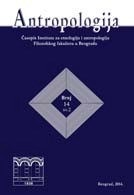NACIONALIZAM MLADIH MAĐARA I SRBA U TEMERINU U UPOREDNOM KONTEKSTU
Youth Nationalism Among Hungarian and Serbian Residents
of Temerin
Comparison with former researches of nationalism among Serbian and Hungarian youth in Serbia
Author(s): Maja KrekSubject(s): Nationalism Studies, Identity of Collectives
Published by: Институт за етнологију и антропологију
Keywords: ethnic nationalism; youth; comparative analysis; theoretical limitations
Summary/Abstract: The aim of this article was to get to some more general conclusions through the secondary analysis of various research of Serbian and Hungarian ethnic nationalism among young people in Vojvodina. Special attention is paid to the research of nationalism among Hungarian and Serbian youth in Temerin, this town being the place of the worst inter-ethnic relations in Serbia, where incidents on ethnic grounds involving young people constantly occure. The studies that have been carried out by Đurić, Ilić, Cvejić, Ristić, Nagy, Kicošev, Keveždi, Manić, Marković, and Tátrai have been analyzed. For the purpose of the analysis the author made her own reclassification of database collected by Ilić and Keveždi, dividing generational group of young people to the age subcategories, with the use of contingency coefficient as a measure of correlation. The results of the analysis show that relatively independently of the methodology applied in research (Katz-Braly technique, Bogardus scale, open-ended questions) the result is that ethnic nationalism is most prominent in very young Serbs and Hungarians, aged up to 23 years. Respondents that are 24–36 years of age are much more tolerant and closer in their views to those older than 37. This finding is placed in the broader context of numerous studies of youth nationalism in Serbia, which speak of the decisive influence of social factors in the last twenty years on the rise of ethnic nationalism among the youngest. The most important result of the analysis is that the modernization theory and the theory of ethnic competition proved to be useless in explaining of ethnic relations in Serbia. These theories are associated with the process of modernization. This process is absent in Serbia for more than two decades, which makes them unable to successfully direct the research of ethnic relations.
Journal: Antropologija
- Issue Year: 16/2016
- Issue No: 1
- Page Range: 9-32
- Page Count: 24
- Language: Serbian

